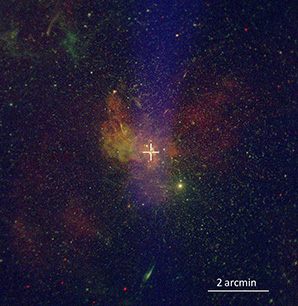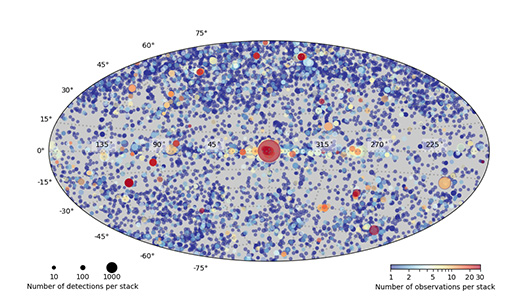New Version of Chandra Source Catalog Released
The Chandra Source Catalog (CSC) is the definitive catalog of X-ray sources detected by the observatory. The latest version, known as CSC 2.1, was released in early April 2024.
Since the Uhuru satellite in the 1970s, X-ray astrophysics missions have a tradition of publishing detailed catalogs of the X-ray sources detected along with a list of key physical properties.
CSC 2.1. carries this tradition forward. Below is an adapted announcement from members of the team who worked on this important resource for the scientific community:
The Chandra X-ray Center (CXC) is pleased to announce the availability of Release 2.1 of the Chandra Source Catalog (CSC 2.1). This catalog covers roughly 730 square degrees of sky and contains 407,806 unique X-ray sources and over 1.3 million individual source detections identified in more than 15,000 Chandra imaging observations released publicly prior to the end of 2021.
The sensitivity limit for detecting point sources of X-rays for most observations is roughly 5 X-ray photons over much of the field of view, allowing us to reach the faintest sources in the X-ray sky. Catalog astrometry -- involving accurate measurements of the positions of stars -- is tied to star positions determined by ESA’s Gaia billion-star surveyor mission for the best sky positions for catalog sources, with a systemic error in position of approximately 0.29 arcsec. For context the full Moon is about 1,900 arcsec across.
For use by astronomers in their research, a wide variety of properties for sources and detections are provided. These include positions, significances, spatial extents, aperture photometry fluxes, hardness ratios, spectral model fits, and temporal variability properties, in multiple energy bands. All properties have associated independent lower and upper confidence limits. Along with tabulated data, the catalog includes roughly 40 different types of data products (e.g., spectra and responses, light curves, Bayesian marginalized probability density functions for aperture photometry fluxes, extended source region polygons) for individual and co-added observation detections and sources, enabling fast scientific analysis without having to perform extensive preparatory data processing.
The catalog can be queried using multiple interfaces, including CSCview, WWT, a simple web interface, and IVOA compliant services. The latter allow access from Jupyter notebooks via PyVO. For further information, consult the catalog webpage: http://cxc.cfa.harvard.edu/csc/.
Kudos go to the CXC Data System and Science Data System science, software development, and operations staff who supported the production of the CSC, for their hard work and dedication in completing this major update to the catalog.
As can been seen from the figure below, the exquisite performance of Chandra’s X-ray optics enables the CSC to excel in crowded regions of the sky. Left : The figure shows a cutout of a roughly 3 Ms observation stack (a co-add of 86 observations) from CSC 2.1, centered on Sgr A* (2CXO J174540.0-290028; identified by the cross), the supermassive black hole at the center of our Galaxy. Color is based on mean photon energy in a pixel (softer, less energetic photons are red, harder, more energetic photons are blue); the vertical blue bar visible in the center of the field is an artifact of summing multiple observations. Right : The positions of roughly 3,300 X-ray point sources in this region from CSC 2.1 are identified. This is roughly a dozen times more X-ray sources than have been detected by other missions, which cannot match Chandra’s superb imaging capabilities.


-Ian Evans, CXC

